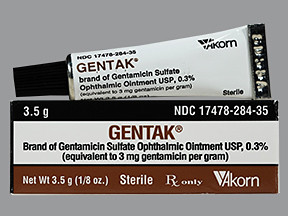GENTAMICIN OINTMENT - OPHTHALMIC
PHONETIC PRONUNCIATION: (jen-ta-MYE-sin)
COMMON BRAND NAME(S): Garamycin
GENERIC NAME(S): gentamicin sulfate
Uses
USES: This medication is used to treat bacterial infections (such as blepharitis, conjunctivitis) of the eye and the skin around the eyes (such as eyelids). It is also used to prevent infection after eye injury or surgery. It belongs to a class of drugs known as aminoglycoside antibiotics. Gentamicin works by killing the bacteria. This medication treats only bacterial eye infections. It will not work for other types of eye infections. Unnecessary use or misuse of any antibiotic can lead to its decreased effectiveness.
How to use GENTAMICIN OINTMENT - OPHTHALMIC
HOW TO USE: To apply eye ointment, wash your hands first. To avoid contamination, be careful not to touch the tip of the tube or let it touch your eye, eyelid, or any other surface. Apply to the eyes only. Do not swallow or inject. Do not wear contact lenses while you are using this medication. Sterilize contact lenses according to the manufacturer's directions, and check with your doctor before you begin using them again. To apply eye ointments, tilt your head back, look up, and gently pull down the lower eyelid to make a pouch. Place a half-inch (1.3 centimeters) strip of ointment into the pouch as directed by your doctor. Gently close the eye and roll the eyeball in all directions to spread the medication. Try not to blink and do not rub the eye. Repeat these steps for your other eye if so directed. Wipe the tip of the ointment tube with a clean tissue to remove extra medication before recapping it. Wait several minutes for your vision to clear before driving or operating machinery. The dosage is based on your medical condition and response to treatment. Your doctor may direct you to use this medication more often at first, then use it less frequently as the infection improves. Do not increase your dose or use it more often than directed. Your doctor may prescribe gentamicin drops for use during the day and gentamicin ointment at bedtime. If you are using another kind of eye medication (such as drops or ointments), wait at least 5 minutes before applying other medications. Use eye drops before eye ointments to allow the drops to enter the eye. Use this medication regularly in order to get the most benefit from it. To help you remember, use it at the same times each day. Continue using it for the full time prescribed. Stopping the medication too soon may allow the bacteria to continue to grow, which may result in a return of the infection. Tell your doctor if your condition persists or worsens.
Side Effects
Precautions
Interactions
Overdose
Images
Reviews
Faq for GENTAMICIN OINTMENT - OPHTHALMIC
Gentamicin ointment is primarily used for the treatment of bacterial eye infections, such as conjunctivitis and blepharitis.
Gentamicin belongs to a class of antibiotics called aminoglycosides. It works by inhibiting the synthesis of proteins in the bacteria, thereby stopping their growth and eliminating the infection.
Wash your hands thoroughly before applying the ointment. Tilt your head back and pull down the lower eyelid to create a small pocket. Squeeze a thin strip of ointment (about 1/2 inch) into the pocket and then close your eyes gently. Wipe away any excess ointment.
It is generally advised to avoid wearing contact lenses during the treatment period, as the ointment may interact with the lenses and cause discomfort. Consult your doctor or healthcare professional for specific instructions.
Common side effects include temporary burning or stinging sensation in the eyes, blurred vision, itching, redness, and eye irritation. If any severe reactions occur, such as swelling or difficulty breathing, seek immediate medical assistance.
Follow the dosage instructions provided by your doctor or pharmacist. Generally, it is recommended to use the ointment several times a day for at least 7-10 days. Do not stop using it prematurely, even if your symptoms improve.
Yes, Gentamicin ointment can be used in children. However, it is important to consult a pediatrician for proper dosage instructions and to rule out any potential contraindications.
Gentamicin ointment is generally considered safe to use during pregnancy and breastfeeding if prescribed by a healthcare professional. However, it is recommended to discuss any potential risks and benefits with your doctor before using it.
Gentamicin ointment is specifically formulated for ophthalmic use and should not be used for other types of infections without proper medical advice. Using it inappropriately may lead to ineffective treatment or the development of antibiotic resistance.
Disclaimer
IMPORTANT: HOW TO USE THIS INFORMATION: This is a summary and does NOT have all possible information about this product. This information does not assure that this product is safe, effective, or appropriate for you. This information is not individual medical advice and does not substitute for the advice of your health care professional. Always ask your health care professional for complete information about this product and your specific health needs.


No Reviews Yet